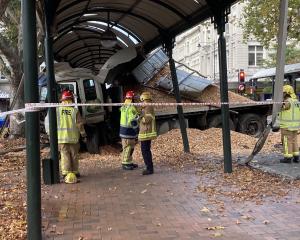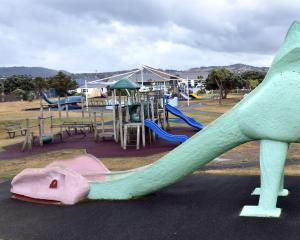Pictures of pigs in single sow stalls featured in a television current affairs programme have shocked animal lovers around the country, but a Dunedin farmer stands by indoor pig farming.
Agriculture and Biosecurity Minister David Carter yesterday confirmed animal welfare investigators were inspecting the farm at the centre of the programme, which was named by Save Animals from Exploitation (Safe) as being owned by former New Zealand Pork Industry Board chairman Colin Kay.
Mr Kay told news media after the inspection investigators did not find anything wrong with the farm.
But Maf released a statement soon after the inspection that said it had not reached any conclusions. Inspectors would be completing their reports, which would include any recommendations and conclusions.
This would enable Maf to decide what, if any, further investigation was required, the statement said.
Pieter Bloem and son Gavin farm 300 breeding sows in sheds on their Highcliff properties and while they do not use single sow stalls, they do use group sow stalls and farrowing crates.
"We make good affordable food for everyday people - not just the elite."
Sows were kept in groups of up to 12, in stalls big enough for them to turn around, and were automatically fed a mix which included barley, wheat, soy, vitamins and minerals, he said.
When ready to give birth, the pigs were herded into farrowing crates, which were heated and had grated floors. The stalls prevented the sows from sitting or lying on their piglets, which meant only a 10% piglet fatality rate, he said.
As for animal welfare, Mr Bloem said he was taking care of the pigs' needs and it was shown in the farm's performance - 25.5 pigs weaned per breeding female.
"We'd not be getting the performance we get if the pigs were stressed."
Each week, he produced 140 pigs, which were sent to Timaru for processing and then on to retailers, mostly in the South Island.
Meeting industry standards which aimed to phase out long-term use of sow stalls was difficult for farmers facing tough economic times and most importantly a lack of skilled labour, he said. He had got around that by hiring trained staff from the Philippines.
"There's not much [in] pig farming."
Most people who criticised indoor pig farming had never been to one. Only a few places in the country, such as Canterbury, were suited to outdoor pig farming, Mr Bloom said.
In contrast, the pigs at Havoc Prime Pork Product's farm at Waimate were raised free-range, with as little intervention as possible. The farm did not use antibiotics or growth enhancers and pigs were fed a diet of locally grown grain with cider vinegar and garlic.
Owned by Linda and Ian McCallum-Jackson, Havoc also appeared on the Sunday television programme.
Mrs McCallum-Jackson cried when she watched the report.
"I knew it happened, but I've never been in to see sow stalls. The pigs can't exhibit their natural behaviour that way. It's absolutely wrong."
A third of the farm's products went to internet orders, another to the Otago Farmers Market and the other to restaurants and suppliers.
Arguments of increased costs if all New Zealand pig farms became free-range did not "wash" with her.
"It depends how much profit you want to make. I like to sleep at night and if I treated my pigs like that I couldn't . . ."
She believed her pork was similar in price to the "best of the worst" found at supermarkets.
The reason pork was so cheap in New Zealand was because so much of the product came from overseas, so she wanted people to support New Zealand pork production, she said.
New Zealand Pork Industry Board chairman Chris Trengrove said in a statement the industry was phasing out long-term use of sow stalls and was more than halfway there.
"Consumers need choice, like choosing between eggs. Some people are happy to pay a premium for free range."
NZ pork production
Pig Farming in NZ:
• About 45,000 breeding sows are farmed.
• They produce about 700,000 pigs for slaughter.
• Pork production averages 49,000 tonnes a year.
• Number of specialist pig farms halved between 1990-02.
• Farms now number 360. 56% of pig population is in herds of over 1000.
• Canterbury and Waikato regions major producers.
• Industry co-ordinated by NZ Pork Industry Board.
• More than 30% of sows run free.
*Source: Maf/NZ PORK
Buying pork:
• In 2007, 800,000kg of pork was imported from countries such as Canada, the US, Australia, China, Scandinavia and Denmark.
• For free-range New Zealand pork or bacon look for labels saying "free-farmed" or "free-range" or bearing the blue "SPCA Approved" sticker on the packaging.
• For New Zealand products, look for 100% New Zealand Pork label.
- Additional reporting NZPA












